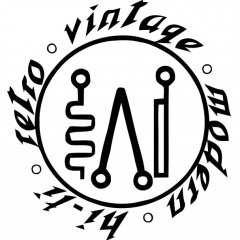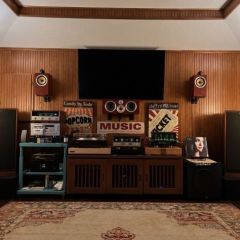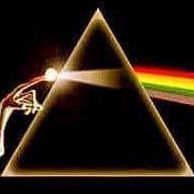Leaderboard
Popular Content
Showing content with the highest reputation on 10/30/13 in all areas
-
Nothing wrong with the sub cable you are looking at on Amazon. Good price. Copper is copper.....don't get caught up in the marketing hype of "High end" cables. You won't hear any difference between those two cables. The monster just looks cooler. Monster has the interlocking (not sure what they call it) barrel tips and although they do grip stronger than other cables, that's actually a bad thing because when you try to remove it from an input, it takes a lot of force and you could begin to weaken a solder joint on the inside of your amp. I always use a single Digital Coax sub cable with a Y at the sub end for the sub. Some subs won't work unless you have both Left and Right channels connected while others do not get as much signal with only a single cable connected.2 points
-
Might as all put up a recent picture... now used to hang my side surrounds like so:1 point
-
1 point
-
1 point
-
2 of the 2μf 1 of the 8μf per box I highly recommend holding off on caps until you take delivery of them and see what they're physically equipped with. Klipsch used two different styles. Earlier cabs used large can type, where as later versions used potted, radial-lead types. Being that the HIP is a pro audio speaker and voiced accordingly, what could very easily be mistaken for an excessively bright (or loud) top end responds exceptionally well to a touch of shelving EQ. -3 dB from 500 Hz to 10 kHz is all it took to make my pair sounding very nice. Besides, there will be other housekeeping items that arguably take precedent over the filter network...like replacement driver-to-horn gaskets for the midrange. For a couple of bucks, I'd buy and install those first before anything else. That will get you inside the cab where you can then check all the fasteners (in particular the screws holding together the tweeters), check the seals, the terminal block, and inspect for bugs and whatnot. Congrats on your purchase. Look forward to seeing some photos when you get'em.1 point
-
If you don't have it already get "Walk on the Wild Side" on vinyl, not cd or download. When the ladies sing you will experience one of the best stereo effects I know. Particularly the second chorus where the girls seem to walk right out of the speaker and right up to you. Tres cool.1 point
-
Dynamat is easy to apply, but I don't know if it makes much difference in the sound. I did apply it to my K400 horns shortly after I got the speakers. I've read that casting the aluminum horns was difficult, and there was an issue with the molds. Some of the horns are a bit rough-looking, even in the inner side that's visible in assembled speakers. The K401 horns cost less, look better, and sound better.1 point
-
1 point
-
Good to hear especially after waiting for almost 5 months. This is on my short list for early next year if the great reviews continue.......1 point
-
1 point
-
Ah, like these? I didn't realize they had both ported and sealed versions. Guess it's really more vented than ported.1 point
-
I used dynamat. I cannot claim it made an audible difference, as I made quite a few other mods at the same time (k-52 and k-79-k). Of course, after all the mods, the speakers are much improved but cannot quantify the dynamat effect. Since I had the speakers apart, I couldn't see that the dynamat would do any harm and I certainly did have the "honky-ness" at louder volumes.1 point
-
I did this mod in January or February and the clay has been holding just fine. It is a Crayola brand clay. I have had the driver out several times trying different mods and I see no sign separation. The clay claims to be non-drying so I am thinking it will hold. I don't have any estimates on how much clay to damp those larger horns. I just kept adding clay until it was nearly level with the stiffening runners that are molded into the horn body. Of course I stayed away from the mounting flange as not to interfere with mounting. The forte horns mount from the front of the baffle. I also stayed about an 2 inches from the driver so I could change diaphragms later.1 point
-
umisound, Forget the Belle and go for the LaScala center. What has not been discussed is that since you want something with lower space requirements, go for the two piece pro LaScala or LSI, with one of these you can use the top hat wich houses the midrange and tweeter for your center and put the Bass bin to the side. Use LaScalas for your surrounds as well. Roger1 point
-
1 point
-
When I first started investigating horn damping that a suggestion was to wrap the horn with electrical tape to see if it was something worth while. This seemed easy enough and reversible. so I tried it on some Fortes with the resin horn. I wrapped about 4 layers of tape on the midhorn. There was a difference in the sound. I believe it reduced what is referred to as honkiness. The midrange seemed slightly quieter but the added clarity was a benefit IMO. I have since removed the tape and applied 1 pound of nondrying modeling clay to each midhorn. The clay can be removed to restore the horn to original where as dynamat or other products would be most likely impossible to remove. when I tap on an installed horn with the damping it sounds deader than an undamped horn. I understand that a bell sitting(or bolted) on a table rings less than a suspended bell. But if you put your hand on the bell it will ring less whether it is mounted tightly or suspended.1 point
-
La Scala or Belle center, Heresy or KPT series for surrounds. Still some KPT-100 availbale in the Garage Sale section (I use them as rear surrounds with Heresy II as side surrounds; see pic). BTW, why 5.0? No sub for the LFE channel?1 point
-
Here is a Dope from Hope article explaining PWK's advice on this subject. Chris1 point
-
..or Belles. The only differences are form factor, appearance, and typically cost with Belle's typically commanding the higher price. A good pair of La Scalas will set you back about $800-1200, while the same Belles might fetch $500-$700 more. I don't recommend Heresies or Cornwalls for the center since I found that there are some timbre matching issues and audible bass modulation distortion that drowns out Khorn performance. I also do not recommend anything in the home theater line, such as the Reference series, etc. Timbre mismatches are far too great, IMHE. I do recommend moving your electronic rack to one side or the other and to set your television on top of the center (assuming you are planning to use a TV). If using a projector then you will probably need at least an 8' ceiling height in order to make use of the projector's greater area projection capability (again, IMHO). You might be able to get away with Heresy surrounds but there are typically issues with getting these up to ear level (not much higher and certainly not lower) without loss of lf response corresponding to the quarter-wavelength height of the speakers off the floor or ceiling. If you mount from the ceiling, you might be able to adjust the Heresies as surrounds but you will likely need to mount the surrounds a bit further back due to the ceiling height in order to handle coverage differences with the Heresies looking down at your listening chairs. There are some Professional Klipsch surround speakers that will work, too: http://www.klipsch.com/permanent-installation "Strange...but true" Chris1 point
-
"Nov 20,1987; The Aluminum K-400 horn was replaced with the K-401 structural foam horn resulting in slightly improved distortion figures."1 point
-
No, not versus, via. The CNC machine is programmed to cut according to Dav'es tractrix horn shape. The CNC machine cuts out a series of progressively smaller sections on a 3/4" sheet of MDF with registration holes in the corners of each slice. They go together very easily. Dave's horns are very consistant. Don't know why they wouldn't be.1 point
-
Horns are easier to make in slices versus CNC? I'm not buying that one... repeatability alone warrants digitization. Perhaps i didnt get the meaning accurately... which wouldn't be the first time1 point
-
I've read many articles relating to people damping horns, whether they be Klipsch, Altec, etc. I read one article where a guy was coating the exterior of his Altec 811's with a heavy mix of bondo and sand. Perhaps that is why MDF has become such a popular choice for DIY horn designs. Horns are easily made in slices via a CNC machine, and its resonant frequency is so low, it's inaudible. (Dave H, I don't mean the designs, prototype, or testing is easy. Based on what I have read here, it's apparent that you spend countless hours perfecting your horns before someone like me can buy a kit.)1 point
-
If I remember correctly on one of the tours from Jim it was mentioned that cost is the reason they went to 400 to 401.1 point
-
What you're seeing may be Moretite window caulking. You can Google. Out of the box it looks like a roll of ribbon cable (though bigger). When used as caulking you unwind a single "wire" of the ribbon cable and have a string of caulk about 1/8 inch in diameter which can be pushed into the gap between a sliding window and the larger frame, or any long, thin gap. It is probably made of clay and some sort of low volatility oil or glycerin. Probably like modeling clay. The idea that the Klipsch mid horn needs damping, even more than provided by screwing the mouth to the front plywood board, has been around for a while. People would apply Moretite in strings or multiple width strings (strips). I did not put any credence in this. Modifications are like belly buttons; everyone has one. And the modifier always finds that their mod was an improvement. They never find the mod was worthless or did harm. Cynical me speaking. You should look at the four-part tour of the Klipsch museum with Jim Hunter on YouTube. Near the end he shows the mold used to cast the K-400 aluminum horn. Very impressive. In 1987, Don Keele (big name in audio engineering) was working for Klipsch and designed the K-401 horn which is made from structural plastic (or resin perhaps). I've never read the reasons for the re design. Was it cost, or performance, or both?. It does feature some large rings of material which should increase strength and maybe damping. Look at the History or the Klipschorn on the main site. These technical articles are easiest to find on the website map. There is a lot of interesting material. https://2d73e25b29782b6d6766-9c8af5cbfef16739445bc76457060528.ssl.cf2.rackcdn.com/KhornTimeline_635116436015580000.pdf . In any event, there is reportedly a slight improvement in distortion in the K-401. (I'm sure a lot of people cried, "What are you doing with cheap plastic.) Now whether that is related to resonance the history does not say. But cynical me has to backtrack and say that maybe there is a corresponding slight improvement in distortion when material is added to a K-400. So it is not just a belly button modification. Smile. Best, WMcD1 point
-
Im hanging in there, the bad news is that with the new driver it will weigh 230lbs instead of 190lbs.....S#@t1 point
-
Is the K260 the new mid horn they use in the KLipschorns now, I noticed the specs on the website spec it out as a 2" mid horn.1 point
-
1 point





















